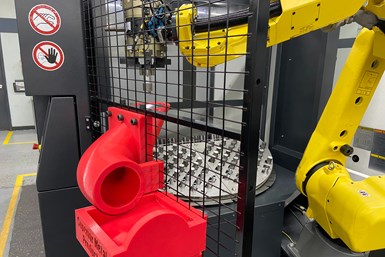Here Are 5 Questions for CNC Machine Shops. Maybe Answer One?
Input from readers like you is always welcome as we make decisions about the types of articles and article topics we pursue for Production Machining.

At Superior Metal Products, 3D printing and robotic automation combined to maximize unattended machining for a chucker lathe. Are either or both of these technologies something you’re considering adding? (Photo Credit: Superior Metal Products)
It’s possible that you’ve never heard of an editorial calendar, but all print magazines have them. Its primary purpose is to ensure the inclusion of content that interests readers and advertisers in each issue. On one hand, they help machining equipment suppliers with the timing of their marketing efforts because the calendar shows precisely what we plan to cover each month. On the other, it’s a tool we editors use to ensure we’re covering a range of topics that we feel will help you, the reader, become more efficient and effective in today’s globally competitive environment.
In developing our calendar, we look for new technologies, machining trends and emerging markets to investigate. But, there are topics we want to cover that don’t make sense to include on the calendar (think workforce development, lean manufacturing, our Emerging Leaders program and so on). To that end, I present five questions here relative to topics we plan to cover next year, and encourage you to email or call me with a response to at least one so I can get a better sense of what stories we pursue. So, in no particular order, I’m wondering:
- Is 3D printing in your shop or on your radar? When I visit shops to profile, regardless of the article topic, I often ask if they have a 3D printer (and how they’re using it) or if 3D printing is something they are considering. 3D printing is often on the radar of those that don’t have that equipment. Shops that have 3D printers (typically polymer, not metal printers) often say they purchased them to play with a bit. That is, to print items such as fixtures, robot grippers and so on for use on the shop floor. Some are starting to take the next step bringing in metal 3D printing equipment, though. If that’s you, I’d like to learn more.
- Are you hoping to apply machine monitoring in a more sophisticated way? Oftentimes, shops start small when delving into machine monitoring, in some cases simply wanting to know when their machines’ spindles are cutting and when they’re not. Companies that offer this technology typically advise shops to do this. But, hearing about shops’ experiences beyond simple spindle current monitoring piques my interest.
- What nonmachining capabilities are you looking to add? These days, production manufacturers are looking to be one-stop shops for their customers. That has them eyeing processes and equipment that can enable them to machine, finish, assemble, package and perhaps even manage inventory for customers. One process example is passivation. For stainless steel parts, passivation often is required to remove any free iron from the part surface, while leaving behind a protective coating. In the past, this was often outsourced because the prevalent method used nitric acid, which is terribly corrosive. Shops didn’t want to jump through EPA hoops or bring such a toxic chemical inside their facility as it could corrode their equipment. Today, though, citric passivation is becoming more widely accepted, especially in the medical industry. This process is as corrosive as orange juice, making it more enticing to bring in-house.
- Are you hoping to bolster your engineering team? High-volume contract shops tend to have tighter relationships with their customers than job shops. More importantly, they have a tighter relationship with their customers’ engineers, some of whom don’t have machining knowledge or in-house machining expertise they can tap for design advice. Instead, these engineers increasingly rely on production machine shops to offer advice for ways to modify new product/part designs to speed and simplify machining. Shops providing this advice early in the new product design/prototyping process often end up winning the production work that will follow, especially given that their design advice has led them to become a trusted vendor.
- Are you more seriously considering machine-tending robots? Bar feeders are the preeminent form of automation in our precision machining industry. Machine-tending robots (including collaborative models that require no safety fencing) are becoming easier to integrate and program and might be a good alternative for a chucker lathe, for example. That way, a machine’s operator can be redeployed to perform more value-adding duties than manually loading and unloading parts.
Please share your thoughts about any of these topics. Plus, remember I’m also always open to ideas for other types of stories you might find helpful as we aim to be a source of discovery for ways you can boost your shop’s overall competitiveness.
Read Next
Cobot Gripper Considerations
There are a variety of ways for collaborative robots to pick up and hold parts and materials. Here are four.
Read MoreVertical Integration Enables Rapid Manufacturing Response
For this contract manufacturer, having myriad machining and manufacturing capabilities in-house enables it to deliver assemblies to customers faster and with higher quality.
Read More3D Printing Creates a Window of Automation Opportunity
For this Omaha shop, periodic part inspection required an automated turning cell to pause production. Printing a plastic parts collection chute for delivery outside the cell solved this problem, and it turns out the shop has found 3D printing to be valuable in many other ways.
Read More















